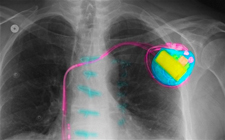redo Jump to...
print Print...
 Note: This article is from the British newspaper The Daily Telegraph.
Note: This article is from the British newspaper The Daily Telegraph.
(By Dean Nelson, Daily Telegraph) NEW DELHI – An American doctor has fitted hundreds of poor Indian heart patients with second-hand pacemakers and defibrillators recovered from corpses in morgues and crematoria throughout the United States.
Dr. Daniel Mescaranhas, a heart specialist from New Jersey, regularly flies to Mumbai with bags of used cardiac devices, as part of a campaign to prove that a pacemaker can still save lives long after its first patient has died.
The reuse of pacemakers and implantable cardiac defibrillators is banned in the United States and not practiced in Britain despite the fact that many of the devices are still in good working order with several years’ battery life after their first patient has died. Manufacturers cite concerns over sterilization and transmission of infections in warning against their reuse.
But according to Dr. Mascaranhas, who is originally from Mumbai, and his supporters from two cardiac units in the city, the lives of thousands of poor heart patients in India and around the world could be saved if second hand pacemakers and defibrillators were more widely accepted and available.
He and his colleagues from Mumbai’s King Edward Memorial and Holy Family Hospitals along with specialists from Texas, Illinois and Pennsylvania, have published new research from operations to fit 81 patients with second-hand devices which found none had suffered an infection in the two years following the procedure.
Dr. Yash Lokhandwala, a cardiologist at Holy Family Hospital and author of their paper in the Annals of Internal Medicine said the patients were mainly poorly paid clerks, manual workers, retirees or unemployed. “One pacemaker would cost them five years income if they spent their entire income on it,” he said.
The proportion of patients fitted with devices in the United States is more than 400 higher than in India because pacemakers and defibrillators are beyond the budgets of most Indians. The devices cost up to 600,000 rupees – around [$11,275] – more than 12 years salary for many of Mumbai’s poor.
“We need thousands and thousands more devices in India. Some western countries do allow them to be reused and it is a shocking waste in those that do not,” said Dr. Lokhandwala.
Information appearing on telegraph.co.uk is the copyright of Telegraph Media Group Limited and must not be reproduced in any medium without license. Reprinted here for educational purposes only. May not be reproduced on other websites without permission from the Telegraph. Visit the website at telegraph.co.uk.
Questions
1. The first paragraph of a news article should answer the questions who, what, where and when. List the who, what, where and when of this news item. (NOTE: The remainder of a news article provides details on the why and/or how.)
2. a) What is a pacemaker?
b) What is a defibrillator?
3. How has Dr. Mascaranhas refuted concerns that used pacemakers and defibrillators could cause infections in the patients who receive them?
4. Who receives the used devices in India?
5. How much would it cost the Indian patients who receive the used devices to pay for a new device?
6. What is your reaction to this news story? (astonished, encouraged, inspired, etc.) Explain your answer.
Daily “Answers” emails are provided for Daily News Articles, Tuesday’s World Events and Friday’s News Quiz.



